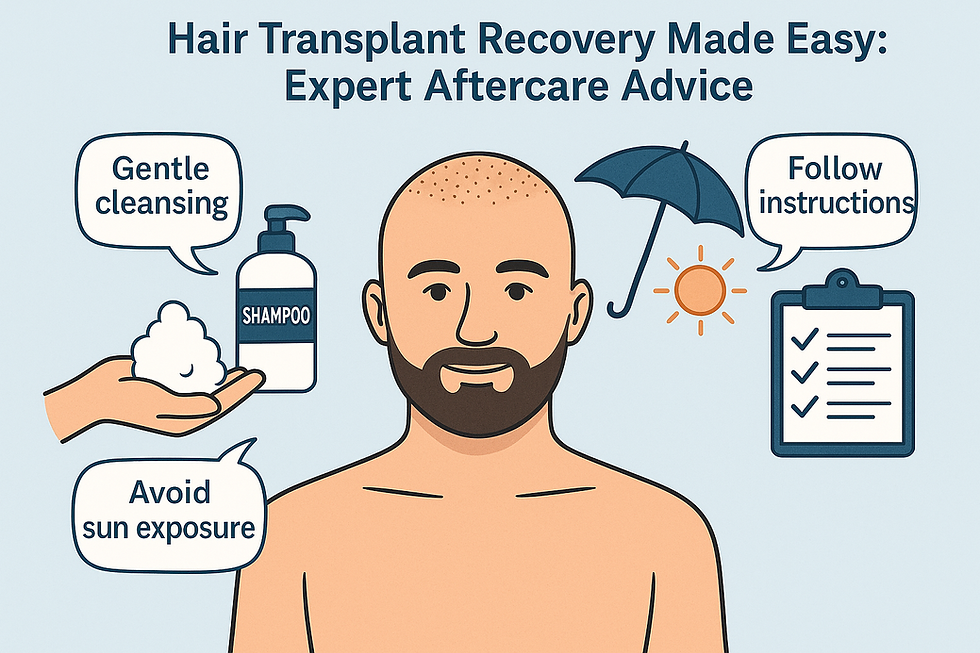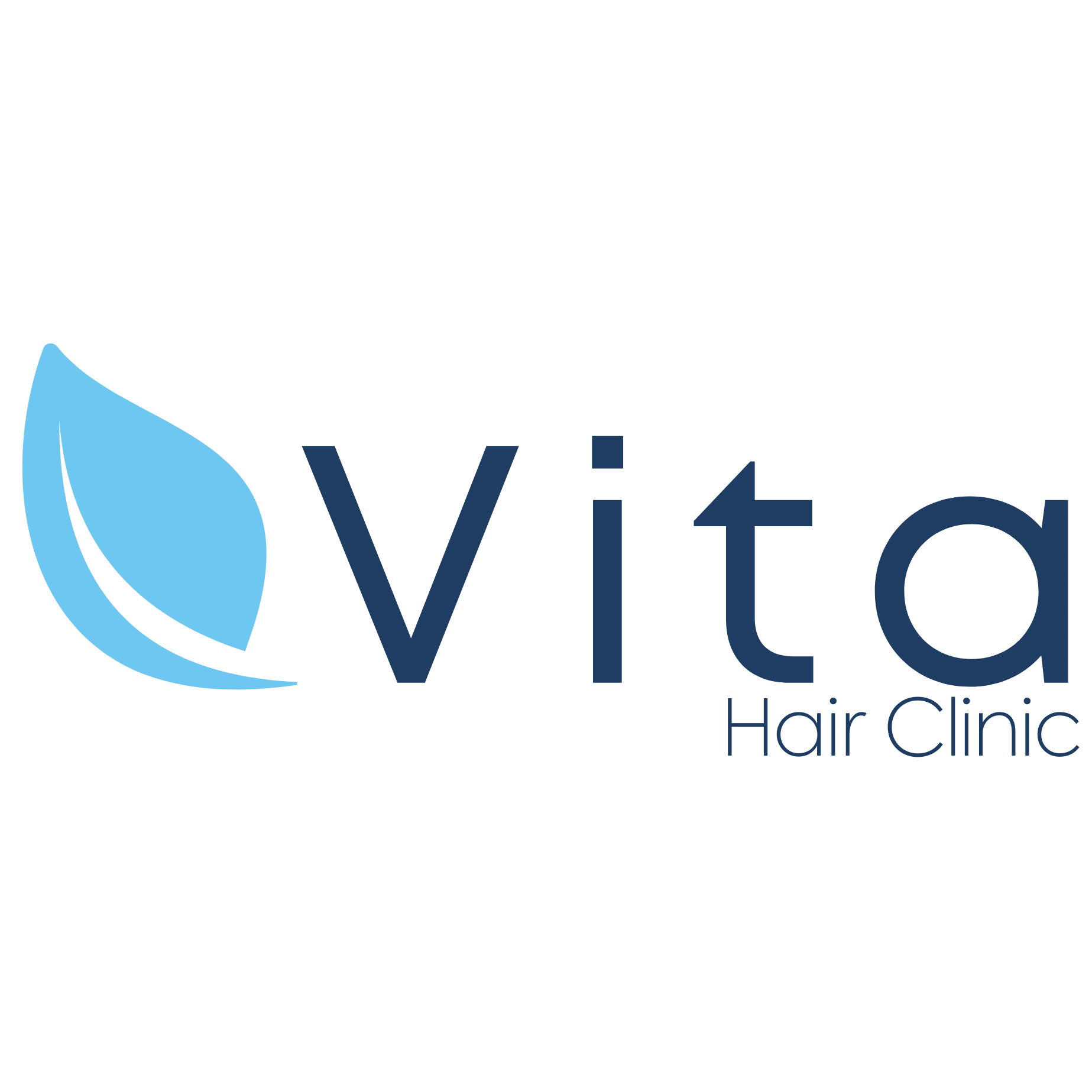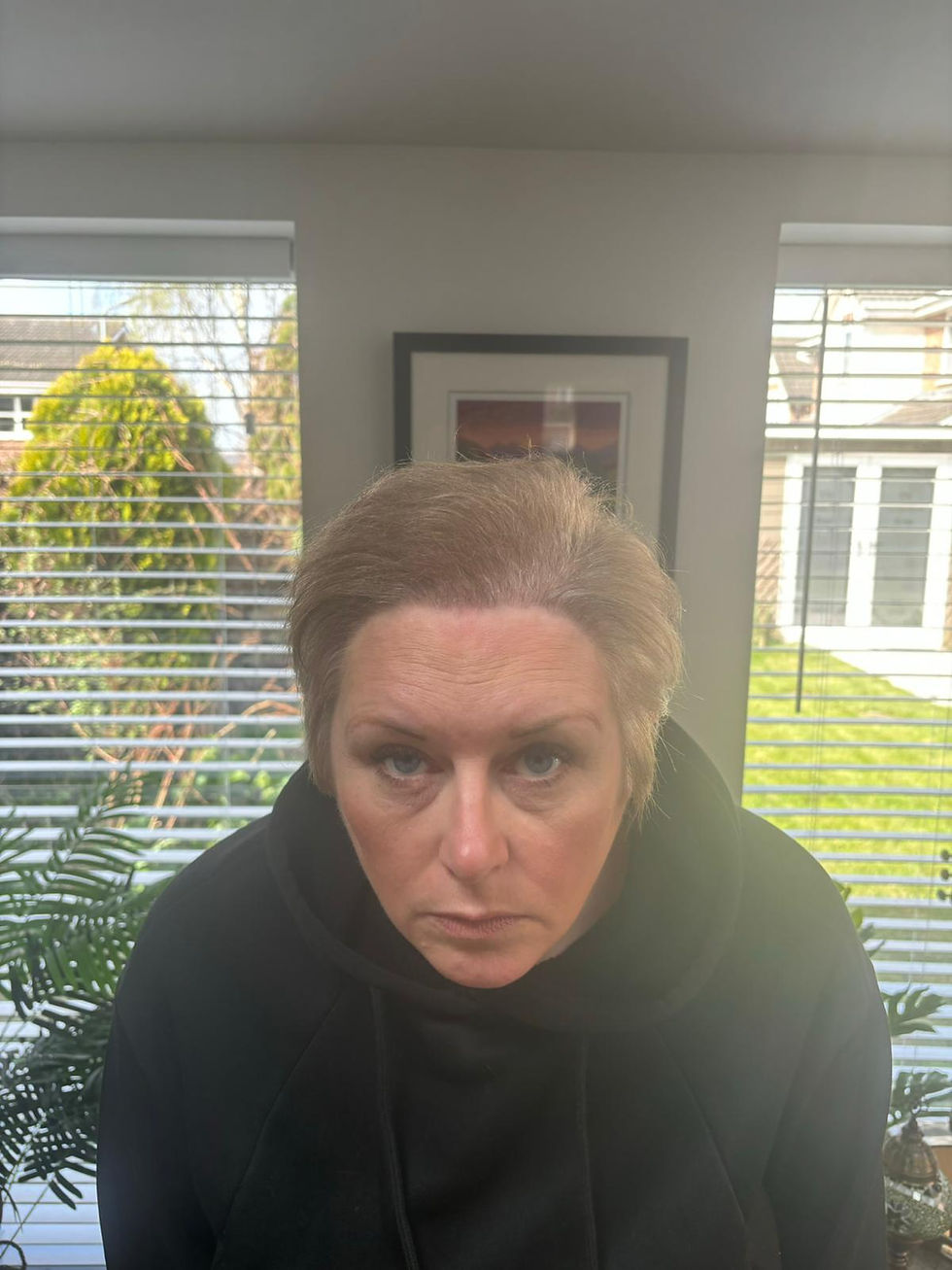Hair Transplant Recovery Made Easy: Expert Aftercare Advice
- Vita Hair Clinic

- Jul 24, 2025
- 11 min read
Updated: Aug 11, 2025

Hair Transplant Recovery and Aftercare are crucial for the success of your hair transplant journey. Understanding the details of post-procedure care is essential to achieving the best results. Here's what you need to know:
Importance of Proper Recovery: Ensuring a smooth recovery leads to healthy hair growth and reduces the risk of complications.
Overview of Recovery Timeline: The recovery process takes several months, with significant healing happening in the first few weeks.
Different Types of Transplants: From Follicular Unit Extraction (FUE), Direct Hair Implantation (DHI) to eyebrow and beard transplants, each type requires specific aftercare measures for the best outcomes.
Starting this journey with knowledge and dedication sets the stage for a successful hair transplant experience. If you're thinking about getting a hair transplant, it's good to know that hair transplant prices in Turkey are often more affordable compared to other countries, without sacrificing quality.
Understanding Hair Transplant Recovery
Hair transplant recovery is a crucial phase that significantly impacts the success of the procedure. Understanding the healing process can help you navigate this journey with confidence:
1. Post-operative Symptoms
After a hair transplant, it's common to experience symptoms such as:
Redness: The scalp may appear red or pink due to increased blood flow during the initial healing phase.
Scabbing: Small scabs can form around the transplanted area as part of the healing process.
Swelling: Some swelling, especially around the forehead and eyes, is normal and typically subsides within a few days.
Soreness: Mild discomfort or soreness in the scalp is expected and can be managed with prescribed pain medication. To better understand the discomfort levels associated with hair transplant procedures, you might find this guide on whether a hair transplant is painful helpful.
2. Timeline for Initial Healing
The initial healing phase after a hair transplant involves:
Immediate Recovery: The first few days are crucial for proper wound healing and minimizing the risk of infection.
Graft Stabilization: Grafts start to anchor themselves in place, laying the foundation for new hair growth.
3. Donor Area vs. Recipient Area Healing
Distinct differences exist between how the donor area (where hair follicles are harvested) and recipient area (where they are transplanted) heal:
Donor Area Healing: Typically heals faster within 5-7 days post-transplant, with minimal scarring due to advanced extraction techniques like FUE.
Recipient Area Healing: Requires more time for grafts to take hold, shed, and regrow new hair, with visible results becoming apparent after several months.
Navigating these phases with patience and adherence to aftercare instructions sets the stage for successful hair transplant outcomes. It's important to note that there can be side effects associated with this procedure and understanding them can aid in better management.
Additionally, if you're considering a more advanced technique like DHI hair transplant, it's beneficial to consult with experienced professionals such as Dr. Kinyas Dusunmez, who can provide valuable insights into your specific case.
Finally, it's essential to have realistic expectations about your hair transplant results over time. A comprehensive understanding of what to expect after ten years post-surgery will help you plan accordingly.
Immediate Post-Transplant Care (Days 1-7)
Taking great care during the first week after your hair transplant sets the foundation for successful healing and growth. This phase, often called immediate hair transplant care, requires gentle attention to your scalp and strict adherence to your surgeon’s instructions.
Managing Redness and Swelling
Apply cold compresses or ice packs wrapped in a soft cloth to your forehead and around the eyes for 10–15 minutes every few hours during the first 48 hours. This helps reduce inflammation and discomfort.
Sleep in a semi-sitting position with your head elevated on pillows for at least two nights. Keeping your head above heart level supports circulation and minimizes swelling.
Protecting Your Grafts
Your transplanted follicles are delicate during this period. Avoid touching, scratching, or rubbing the grafted area. Bandages, if applied, usually stay on for 2 to 5 days—follow your surgeon’s timeline carefully. Disturbing these protective coverings can dislodge grafts and compromise results.
Gentle Washing Guidelines
Around day five, you may begin washing your scalp gently:
Use only mild shampoos specifically recommended by your surgeon, avoiding harsh chemicals or fragrances.
Wash with lukewarm water, softly patting rather than rubbing the scalp.
Avoid high-pressure water streams; instead, let water flow gently over the treated area.
Pat dry with a clean towel—do not rub.
For those who underwent DHI (Direct Hair Implantation), aftercare in this first week emphasizes natural product use and cautious handling of donor and recipient sites. The recipient area is more sensitive, so adhering strictly to these washing instructions supports optimal healing without disturbing grafts.
By focusing on these immediate post-transplant care steps, you create a safe environment that encourages graft stability and reduces common issues like redness and swelling.
If you're looking for more personalized advice or have specific queries related to your post-transplant care, don't hesitate to reach out through our contact page. Additionally, if you're interested in seeing real-life results from our procedures before making a decision, feel free to browse through our before and after gallery.
Essential Aftercare Instructions for Optimal Healing
Taking care of your scalp carefully in the days and weeks following your procedure plays a crucial role in hair transplant recovery and aftercare. This period demands attention to small but impactful habits that protect the delicate grafts and support healthy healing.
1. Avoid strenuous exercise and sweating for at least two weeks.
Physical activities that raise your heart rate significantly can increase scalp blood flow, which risks dislodging the newly transplanted follicles or causing bleeding.
Sweat can also introduce bacteria, increasing the chance of infection. Gentle walks are usually safe, but save gym workouts, running, or anything that makes you sweat heavily until your surgeon gives the go-ahead.
2. Steer clear of substances that may impair healing:
Alcohol thins the blood and delays tissue repair.
Smoking reduces oxygen delivery to your scalp, hindering recovery.
Aspirin and other blood thinners can cause excessive bleeding or bruising around graft sites.
Spicy or salty foods might lead to inflammation or swelling, so it’s better to avoid them during this sensitive time.
3. Protect your scalp from sun exposure and harsh weather during the first month post-transplant.
Ultraviolet rays can damage fragile new grafts and slow healing. If you must go outdoors, wear a loose-fitting hat with a breathable fabric or use a high-SPF sunscreen recommended by your surgeon. Wind, rain, and extreme cold may irritate your scalp and should be avoided when possible.
These hair transplant aftercare instructions help create an environment where grafts settle securely and your scalp recovers without complications. Maintaining these habits supports not just early healing but long-term success too.
Postoperative Recovery Phases: The Shock or Fading Phase
After a hair transplant, patients often experience several recovery phases that are important to understand for setting realistic expectations. One notable phase is commonly referred to as the shock phase or fading phase, which typically occurs within the first few weeks following surgery.
What Happens During the Shock Phase?
Hair Shedding: Transplanted hairs initially enter a resting phase and begin to shed. This shedding is a normal and temporary reaction caused by the trauma of transplantation and the shift in blood supply to the follicles.
Timeline: The shock phase usually begins around 2 to 4 weeks post-surgery and can last several weeks. During this time, transplanted hairs fall out but the follicles remain intact beneath the scalp.
Patient Experience: Many patients notice this hair loss and may feel concerned; however, it is important to understand this is part of the natural healing and regrowth cycle.
Why Does This Happen?
The shock phase occurs because transplanted follicles temporarily pause their active growth cycle due to surgical stress. This process allows follicles to reset before entering a new anagen (growth) phase.
What Comes Next?
After shedding, new hair growth typically begins around 3 to 4 months post-transplant.
Hair gradually thickens and gains density over the following months, with full results often visible by 9 to 12 months.
Supporting Healthy Recovery During the Shock Phase
Follow all postoperative care instructions carefully, including medication use such as minoxidil, which may help stimulate regrowth.
Avoid harsh scalp treatments or physical trauma during this sensitive period.
Maintain patience and communicate with your surgeon about any concerns during recovery.
Understanding the shock phase helps patients navigate initial hair shedding with confidence, knowing that it is a normal step toward achieving natural-looking, lasting transplant results.
Specialized Aftercare for Different Types of Hair Transplants
Eyebrow Transplant Aftercare
When it comes to eyebrow transplant aftercare, specific considerations must be taken into account. Gentle cleaning is crucial to prevent irritation or infection. Additionally, it's important to avoid using makeup or creams that could harm the newly transplanted grafts.
Beard Transplant Aftercare
The beard transplant aftercare(https://vitaestetic.com/beard-implants-your-ultimate-solution-for-facial-hair-growth) process requires a focus on washing techniques. Use gentle washing methods to protect the delicate transplanted hair and refrain from shaving too soon to avoid damaging the grafts.
DHI Hair Transplant Care
For those undergoing DHI hair transplants, there are key aspects to consider in the DHI hair transplant care(https://vitaestetic.com/big-forehead-reduction-surgery) process.
Emphasis should be placed on using natural products to promote healing and reduce the risk of adverse reactions. Furthermore, implementing protective measures beyond the immediate post-operative period is essential for sustained results.
Long-Term Recovery Tips (Weeks 2 to 3 Months)
Understanding the long-term hair transplant recovery process helps you stay patient and confident as your new hair takes shape. Around two weeks after your procedure, you may notice the transplanted hair shedding phase. This is completely normal—your newly implanted hairs temporarily fall out as the follicles enter a resting phase.
New growth typically begins between three and four months post-transplant. This fresh hair will gradually thicken and fill in over the coming months, so try not to be discouraged if progress seems slow at first.
Resuming Physical Activities
Resuming physical activities requires thoughtful timing to protect your grafts:
Moderate exercise such as yoga, walking, or cycling can often be safely restarted about one month after surgery. These activities promote healthy circulation without placing excessive strain on your scalp.
Avoid aggressive physical exertion like weightlifting, running, or contact sports for up to three months. Intense activity increases blood pressure and sweating, which could disrupt graft healing.
Wearing helmets or tight hats is discouraged during this period because pressure on the scalp may compromise graft survival.
Paying attention to these guidelines supports optimal healing and ensures that your transplanted follicles remain secure as they transition from rest to active growth.
Remember, patience during this phase is vital. Healing continues beneath the surface even when visible changes seem subtle. By respecting your body’s natural timeline, you maximize the chances of achieving strong, lasting results from your hair transplant journey.
Medication and Product Use During Recovery
Hair transplant recovery involves careful consideration of medication and product usage to support optimal healing and hair growth. Here are essential points to keep in mind:
Precise Medication Adherence: Following the surgeon's prescribed medications diligently is crucial for promoting proper healing and graft survival post-transplant.
Safe Topical Products: Utilize gentle, natural creams like calendula, sesame, or coconut oil to nourish the scalp without causing irritation or interference with the healing process.
Products to Avoid: Steer clear of certain products that could potentially harm the newly transplanted hair follicles. It is advisable to refrain from using castor oil, hair dyes, sprays, or gels for a minimum of six months following the procedure to prevent any adverse effects on graft growth.
By prioritizing the correct medication regimen and choosing appropriate topical products, you can significantly enhance the outcomes of your hair transplant recovery journey.
Nutrition and Lifestyle Modifications to Support Hair Growth
Taking care of your body from the inside plays a vital role in diet for hair transplant recovery. Nourishing your scalp and new hair follicles with the right nutrients can enhance blood flow and support healthy growth.
Key vitamins for hair growth post-transplant include:
Biotin (Vitamin B7): Strengthens hair follicles and supports keratin production.
Saw Palmetto: A natural supplement that may help reduce DHT levels, a hormone linked to hair loss.
Finasteride: Often prescribed by your surgeon, this medication helps prevent further hair loss by blocking DHT.
Eating a balanced diet rich in proteins, iron, zinc, and vitamins A, C, D, and E encourages a robust environment for new hair. Fresh fruits, leafy greens, nuts, seeds, and lean meats all contribute essential building blocks for follicle nourishment.
Alongside your nutrition, certain lifestyle changes after hair restoration can promote healing:
Engage in gentle activities that boost circulation without causing excessive strain or sweating. Walking or light yoga improves blood flow to the scalp.
Avoid anything that increases cranial blood pressure during early recovery—sexual activity is best postponed for about 10 to 15 days to protect delicate grafts.
Stay well-hydrated to maintain optimal skin elasticity and cellular function.
Manage stress through mindfulness techniques or relaxation practices since elevated cortisol can negatively impact hair growth.
These intentional lifestyle choices create a supportive foundation for your transplanted hair to thrive. Thoughtful attention to what you consume and how you move during recovery contributes directly to long-lasting results and overall scalp health.
Monitoring Progress and When to Consult Your Surgeon
Expected Milestones
The journey from initial healing to full density typically spans 12 to 18 months, with gradual progress and visible changes along the way.
Warning Signs
Watch out for excessive swelling, persistent redness, prolonged pain, or signs of infection in the treated areas. These could indicate complications that require immediate medical attention.
Follow-Up Appointments
Regular consultations with your surgeon are crucial for monitoring progress, addressing any concerns, and receiving personalized advice tailored to your recovery process.
Remember that tracking your hair transplant results goes beyond mere observation; it involves understanding the expected timeline of healing and being vigilant for any unexpected developments. Always prioritize your well-being by seeking professional guidance promptly if you notice any worrisome symptoms.
Conclusion
Your commitment to following surgeon’s instructions closely plays a crucial role in achieving the best possible outcome from your hair transplant procedure. Every step of Hair Transplant Recovery and Aftercare matters—from gentle washing and protecting your scalp to avoiding activities that could jeopardize graft survival.
Keep these key points in mind:
Adhere strictly to medication schedules and aftercare routines prescribed by your surgeon.
Protect your scalp from physical trauma, sun exposure, and harsh products.
Be patient with the natural timeline of healing, shedding, and new hair growth.
Recognize that full results often take 12 to 18 months to become visible.
"Successful hair transplant recovery tips" are not just about quick fixes but building a foundation for healthy, lasting hair growth.
Setting realistic expectations helps you navigate this journey with confidence and peace of mind. Your new hair deserves the best care—treat it gently, stay informed, and don’t hesitate to reach out if concerns arise. This expert aftercare advice summary is designed to empower you with knowledge so your investment in yourself yields rewarding, natural-looking results.
FAQs (Frequently Asked Questions)
What is the typical recovery timeline after a hair transplant?
The typical hair transplant recovery timeline includes initial healing and graft stabilization within the first week, a normal shedding phase around two weeks post-procedure, followed by new hair growth starting at 3 to 4 months. Full density is usually achieved between 12 to 18 months after the procedure.
What are the essential aftercare instructions to ensure optimal healing post-hair transplant?
Essential aftercare involves avoiding strenuous exercise and sweating for two weeks to prevent infection and graft dislodgement, abstaining from alcohol, smoking, aspirin, and certain foods to promote better circulation and healing, protecting the scalp from sun exposure and harsh weather during the first month, and following surgeon-prescribed medications precisely.
How should I care for my scalp immediately after an DHI hair transplant during the first week?
During days 1-7 post-DHI transplant, manage redness and swelling with cold compresses and maintain a semi-sitting sleep position. It is crucial not to touch or disturb grafts during the bandage removal period. Gentle washing can begin around day 5 using mild shampoos and surgeon-recommended products.
Are there specific aftercare considerations for eyebrow or beard hair transplants?
Yes, delicate areas like eyebrows require gentle cleaning and avoidance of makeup or creams that may irritate grafts. Beard transplant care focuses on proper washing techniques and avoiding shaving too soon. For all types, natural product use and longer-term protection strategies are emphasized.
What medications and topical products are safe to use during hair transplant recovery?
It is important to follow surgeon-prescribed medications precisely. Safe topical products include natural creams like calendula, sesame, or coconut oil. Products to avoid for at least six months post-procedure include castor oil, hair dyes, sprays, or gels as they may harm graft survival.
When should I consult my surgeon during the hair transplant recovery process?
You should consult your surgeon if you experience warning signs such as excessive swelling, infection, or any unusual symptoms. Regular follow-up appointments are important for personalized advice and monitoring progress from initial healing through full density at 12–18 months.













.png)
Comments